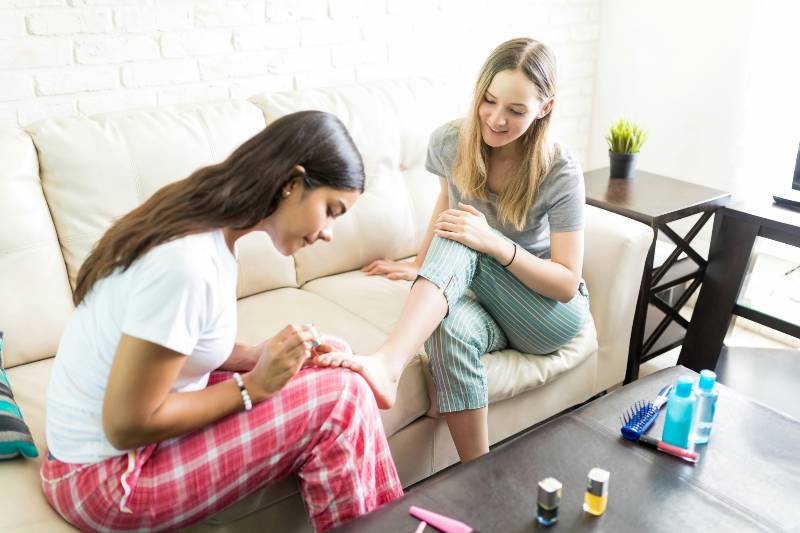You might be worried when you see white, chalky patches on your toenails after taking off nail polish.
It’s not what you expected and certainly not what you hoped for when you polished your nails.
Here we’ll uncover why this happens and how you can effectively address it, ensuring your nails stay healthy and look their best.
Why White Spots Occur on Toenails After Removing Polish?
The presence of white spots on your toenails after removing polish can be startling. It is a condition called keratin granulations, which arises due to the dehydration of your nail’s surface.
Keratin granulations have some relationship with gel polish.
Gel Polish and Its Impact
Gel polish is loved for its durability and glossy finish, but it requires a curing process under UV light that can be quite harsh on your nails. The removal process, too, often involves soaking your nails in acetone, further drying them out.
This excessive drying strips away the natural oils in your nail, leaving the upper layer of the nail, the keratin, vulnerable and rough, leading to those white, chalky patches you see.
The Formation of Keratin Granulations
Keratin granulations form when the top layer of the nail loses its moisture and oils, causing it to appear white and chalky.
It’s similar to having dry skin. Just as your skin flares up and turns white and flaky when it’s dry, your nails respond similarly.
You might notice this issue after taking off nail polish because the polish itself can act as a barrier, trapping moisture out and leading to a significant drying effect on the nail plate underneath.
This drying effect is particularly pronounced with gel polishes, not only because of the harsh chemicals used for removal but also due to the prolonged wear time, which doesn’t allow the nail to breathe and recover.
It’s a cosmetic concern rather than a medical one, but it indicates that your nails could use a bit of tender loving care.
How to Get Rid of Keratin Granulations?
First and foremost, it’s important not to panic. Discovering chalky white patches on your nails can be worrying, but it’s a reversible condition. With a bit of patience and the right approach, your nails can and will recover.
1. Do Nothing
It might sound too good to be true, but one of the best things you can do when dealing with keratin granulations is, well, nothing. Over time, your nails will naturally grow back.
For instance, it could take about 8 to 12 months for a big toenail to fully regrow. During this time, the affected portion of the nail will gradually be replaced by new, healthy nail growth.
2. Moisturize your nails
Just as you would moisturize dry skin, moisturizing your nails is a key step in removing keratin granulations. Applying a moisturizer specifically designed for nails can improve their condition gradually.
There are many products available that are crafted with nails in mind, offering deep hydration and nourishment to restore your nails’ natural beauty and health.
3. Lightly Buff Your Nails with a Nail Buff
Lightly buffing your nails can help clear up the chalky deposits on your nails and make your nails look better fairly quickly. It’s essential, however, to be gentle and not overdo it.
Over-buffing can weaken your nails, making them more susceptible to damage and further drying. A soft buff once a week should be sufficient without causing additional stress to your nails.
4. Don’t Put Another Coat of Nail Polish
You might want to hide those white spots with more nail polish, but it’s better not to. Giving your nails some time to breathe and recover is crucial.
Adding more polish, especially without addressing the underlying issue of dehydration, can lead to a vicious cycle where the nails continue to dry out and weaken, making the problem worse in the long run.
5. See a Podiatrist
If after trying the aforementioned steps you do not see an improvement, or if your nails appear to be getting worse—more white, flaky, or even painful—it might be time to consult a professional.
While keratin granulations are a common and generally harmless condition, you might have a fungal infection called “superficial white onychomycosis.”
A podiatrist can properly diagnose the condition and recommend appropriate treatment. This might involve topical or oral medication, and in some cases, removing the damaged portion of the nail to allow healthy regrowth.
How Long Does it Take for Nails to Recover from White Spots?
The time it takes for your nails to recover from white spots caused by keratin granulations can vary.
Much depends on the extent of the dehydration and damage, as well as how well you care for them during the recovery process.
For the majority of individuals, significant improvement can be seen within a few weeks of consistent care and moisturization. Complete recovery, however, can take longer—especially considering the slow rate at which toenails grow.
As mentioned above, the big toenail, for example, grows at an approximate rate of 1.5 millimeters per month. This means that for a toenail to fully renew itself, it can take anywhere between 8 to 12 months.
The key here is patience. With consistent care, the new growth will be healthy and free of those unsightly white patches.
How to Avoid Keratin Granulations in Your Next Polish?
Preventing keratin granulations from occurring in the first place is the ideal scenario. Here are tips on how to keep your nails healthy and avoid this condition after your next polish:
1. Limit the Use of Harsh Chemicals
Choose nail polish removers that are acetone-free, as acetone is highly drying. When possible, take breaks between polishes to allow your nails to recover.
2. Hydrate and Moisturize
Before applying polish, make sure your nails and cuticles are well-moisturized. Applying a nail oil or cuticle oil regularly can help maintain the hydration levels of your nails, preventing them from becoming dry and brittle.
Continue to moisturize even while wearing polish; you can apply oil at the base of the nail and over the cuticle.
3. Use a Base Coat
Applying a base coat before your color polish can act as a protective barrier for your nail. It not only helps prevent staining from colored polishes but also reduces the direct contact of harmful chemicals with the nail surface, thereby minimizing damage.
4. Opt for Healthier Polish Options
Nowadays, there are nail polish options available that are formulated to be less harsh on nails. Look for “5-free” or “7-free” polishes, which are free from the most harmful chemicals found in traditional polishes. There are also water-based polishes that are even gentler.
5. Stay Away from Gel Polishes When Possible
Although gel polishes last longer and have a brilliant shine, they require UV light for curing, which can weaken nails over time. The removal process, involving soaking in acetone, further damages the nails.
If you love the look of gel polish, try to reserve it for special occasions rather than regular wear.
6. Regular Nail Maintenance
Keeping your nails trimmed and filed can prevent them from snagging and breaking, which can exacerbate dryness and damage.
Regular maintenance helps in keeping nails in good shape and prevents the accumulation of dirt and debris under the nail, which can contribute to various nail ailments.
7. Wear Gloves for Protection
When doing household chores, especially those involving water and cleaning agents, wear gloves to protect your nails. Repeated and prolonged exposure to water and harsh chemicals can strip the nails of their natural oils, making them more susceptible to dryness and keratin granulations.
8. Eat a Balanced Diet
Your nail health, like the rest of your body, is influenced by what you eat. Ensure your diet includes a good balance of vitamins and minerals, particularly those known to support nail health.
Vitamins A, C, D, E, B-complex, as well as minerals like zinc, iron, and magnesium, play a crucial role in maintaining strong and healthy nails.
9. Stay Hydrated
Adequate hydration is vital for maintaining the overall health of your skin and nails. Drinking enough water each day helps to ensure that your body, including your nails, gets the moisture it needs to stay healthy.
10. Consult With a Professional
If you’re unsure about the health of your nails or how best to care for them, consulting with a professional such as a dermatologist or podiatrist can provide you with tailored advice. They can assess the condition of your nails and recommend specific treatments or products that align with your nail health needs.
Taking proactive steps in caring for your nails not only helps avoid issues like keratin granulations but also promotes overall nail health and aesthetics. It’s important to remember that beautiful nails start with healthy nails.
By implementing these preventive measures, you’re not just avoiding white spots after polish removal; you’re committing to the long-term health and beauty of your nails.
Conclusion
The appearance of white chalky patches on your toenails after removing polish can be an alarming discovery, but it’s often a treatable and preventable condition known as keratin granulations. This issue underscores the importance of nail care, highlighting the need for hydration, protection, and mindful choices in nail cosmetics.
With patience, care, and a bit of knowledge about how to protect and rejuvenate your nails, you can keep them looking and feeling their best.





